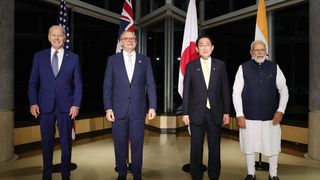In the face of an array of competing priorities, the Biden administration scored landmark achievements in its Indo-Pacific defence networks in 2023. But new challenges loom large in 2024.
Since entering office, the Biden administration has been unwavering in recognising that US Indo-Pacific allies are a “force multiplier” and the country’s “greatest asset.” Administration officials promised that 2023 would be the most transformative year in US regional force posture in a generation. Though this claim faced heavy scepticism at the time, it was borne out in dramatic increases in the scale and ambition of US defence cooperation.
At the outset of 2024, this article assesses key achievements from last year and obstacles on the horizon. The US standing in the Indo-Pacific improved in 2023, buoyed not only by progress in a spate of security partnerships but also by partners’ increased willingness to collectively confront China’s destabilising behaviour in the region. With ongoing conflicts in Europe and the Middle East and strategic competition in the Indo-Pacific only intensifying, 2024 stands to be a fraught year for US foreign policy. In the face of new pressures, the administration must keep its attention equally trained on the region in 2024.
The role of allies and partners in strategic competition with China
As strategic competition between the United States and China in the Indo-Pacific has intensified, coalition-building efforts have ensued. Though most countries’ cooperation with China is primarily economic, China is also advancing defence partnerships in the region. President Xi Jinping’s Global Security Initiative seeks to build a model of “indivisible security” in the region. In 2023, the People’s Liberation Army (PLA) conducted an array of bilateral exercises with Thailand, Laos, and Cambodia and regular joint patrols of the Mekong with Southeast Asian partners. Beijing sought further cooperation through arms sales and joint naval exercises–including the forthcoming sale of a frigate and a submarine to Thailand and through the multilateral exercise “Peace and Friendship 2023.”
The US Department of Defense acknowledges that it cannot confront strategic adversaries alone and that security threats are best confronted far away from US shores. Its long-standing alliances with Japan, South Korea, the Philippines, Australia, and Thailand underpin all recent strategy documents. These realities are well understood by the public, with more than half of Americans thinking that US alliances with Australia (53 per cent) and Japan (52 per cent) make the United States more secure. The United States maintains a distinct edge over China in the strength of its regional defence partnerships. The US military conducts 120 exercises annually with partner countries in the region.
The Biden administration’s record on Asia policy in its first two years in office was mixed. Though there were certainly highlight moments for its Indo-Pacific alliances, critics argued that the administration was “struggling to act on its [Indo-Pacific] agenda with the urgency required.” Senior official diplomacy got off to a slow start in Southeast Asia and had an outsized concentration on Europe. The most glaring issue was the administration’s failure to advance a trade policy for the region to compensate for President Trump’s withdrawal from the Trans-Pacific Partnership. Administration officials fortified traditional Indo-Pacific alliances through regular engagement and expanded force posture cooperation, but ‘heavy lifting’ remained to advance US standing in the region more broadly.
Empowered partners for competitive advantage
In 2023, progress in US Indo-Pacific defence partnerships was substantial and more convincing than any adjacent Chinese efforts. The Biden administration succeeded in three key areas: it modernised its defence partnerships, networked partners through strategic trilateral and multilateral groupings, and empowered its allies to better provide for their national defence. The Biden administration progressed the aims of its Indo-Pacific Strategy by demonstrating closer substantive cooperation with its bilateral defence allies. Two Australia-US Ministerial Meetings led the alliance into previously “uncharted territory” in its force posture cooperation–the continued rotation of US Bomber Task Forces and the future rotational deployment of nuclear-powered submarines stand out as the most advanced efforts. The administration initiated further deployments and additional cooperation on defence technology and defence supply chains with Japan. It strengthened its commitment to the combined defence of the Republic of Korea through the Washington Declaration. The Philippines granted the United States access to four additional bases under the Enhanced Defense Cooperation Agreement. Taken together, these initiatives demonstrate a high degree of trust in partners and a long-term commitment to regional partnership.
Modernisation efforts extended beyond traditional allies. The administration also made inroads in the Pacific, signing a major defence pact with Papua New Guinea. India and the United States increasingly demonstrated their alignment, expanding defence industrial cooperation and enhancing interoperability through the India-US Defense Acceleration Ecosystem. President Biden upgraded US-Vietnam relations to a Comprehensive Strategic Partnership in September, a move US officials have long pursued. Biden similarly elevated US-Indonesia relations in November. These moves expanded the regularity and sophistication of US defence cooperation in Southeast Asia.
The administration enriched trilateral and multilateral networks that will further US objectives in the region moving forward. In March, the optimal pathway to implementing the Australia, UK, and US AUKUS partnership on nuclear-powered, conventionally armed submarines was unveiled. If successful, this partnership will further commit the United Kingdom to the region and dramatically increase Australia’s naval capability. AUKUS advanced technologies were trialed for the first time in areas such as cyber security, electronic warfare, and information sharing. President Biden hosted Japanese Prime Minister Fumio Kishida and South Korean President Yoon Suk-yeol at Camp David for a historic summit, demonstrating a previously unattainable degree of alignment. The Trilateral Strategic Dialogue with Japan and Australia was also strengthened–most recently, with the expansion of trilateral defence cooperation to include unmanned aerial vehicles. In October, Japan invited Australia to join two regular command post-military exercises it holds with the United States.
The above commitments have breathed life into more coordinated US regional force posture and defence cooperation in 2024. The National Defense Authorization Act signed in December 2023 authorised $14.7 billion for the Pacific Deterrence Initiative and extended it through fiscal year 2024. However, with an enormous and growing list of defence cooperative initiatives and a limited capacity, implementation remains daunting.
Winning the competition for ideas
To be successful in strategic competition, the United States must win a competition of ideas in the Indo-Pacific. The shift in regional partners’ perceptions of the importance of the rules-based order and the risks posed by China was perhaps the Biden administration’s greatest success in 2023. Many experts lamented the administration’s heavy-handed emphasis on championing democratic values in its early months in office. This approach neglected regional dynamics and alienated prospective partners in Southeast Asia and the South Pacific, many of whom are not democracies or, like the Philippines and Thailand, are experiencing democratic regression.
By framing threats to regional stability in terms of state sovereignty and freedom from coercion in 2023, the Biden administration spoke to the region in terms it understands. In 2023, key documents like the 2023 Quad Leaders’ Statement and the most recent Australia-United States Ministerial Consultation (AUSMIN) joint statement focused on “sovereignty,” “territorial integrity,” and freedom from coercion, values that are prized across the region. Shortly after, however, China violated these norms, as Chinese vessels continuously blocked, fired water cannons at, and rammed Filipino ships on resupply missions to Filipino forces at Second Thomas Shoal. China also harassed Malaysian and Vietnamese vessels in their Exclusive Economic Zones (EEZ). Either due to more artful US messaging or China’s behaviour, US Indo-Pacific partners vocally critiqued Chinese behaviour for threatening regional peace and stability.
More frequent efforts by US partners to cooperate independent of the United States represented another critical development in 2023. Japanese Prime Minister Kishida and South Korean President Yoon are engaging bilaterally on shared concerns for their strategic environment. For the first time, an Indian submarine visited Australia’s port HMAS Stirling, and Australia, Indonesia, and India conducted a trilateral sail. Most credit for this growing convergence of US coalition partners has been given to Xi Jinping’s behaviour in causing regional instability. Regardless, these developments are undoubtedly beneficial for US interests.
Avoiding self-sabotage in 2024
Competing for influence in the Indo-Pacific has become a bipartisan priority in an otherwise divided US Congress. The Freedom Caucus, which exercises significant influence in the House and has been hostile to US commitments in other regions, has collectively recognised the importance of succeeding in strategic competition with China. Altogether, political factions agree on the priority placed on Asia–the greatest question now surrounds the urgency of implementation.
Dysfunction in the US Congress throughout the year is a troubling reminder that domestic politics are the greatest determinant of US objectives in Asia. Delays in the passage of the National Defense Authorization Act left spectators concerned about the future of key enablers of US defence cooperation in the Indo-Pacific. Both sides of the aisle are committed to a firm Asia strategy, but costly commitments far away from the mainland United States are always vulnerable to public scrutiny. US Indo-Pacific strategy hangs in the balance of the US presidential election in 2024.
Trade, already the weakest component of US engagement in Asia, is the policy area with the most tenuous prospects. Former President Trump, the probable Republican nominee, has sworn that the Indo-Pacific Economic Framework (IPEF), the only trade-related initiative the Biden administration has advanced to the region, would be “dead on day one.” With free trade lacking support at the political level among both Democrats and Republicans, pursuing an economic agenda attractive to Indo-Pacific partners will be difficult. In 2023, the Biden administration abandoned the digital trade negotiations of both the World Trade Organization and IPEF without pursuing an alternate solution. For US ambitions of presence and influence in Asia to be realised to the fullest extent, the victor in 2024 must marry its defence cooperation with tangible economic initiatives.
The Biden administration has strengthened its Indo-Pacific alliances and partnerships. To win over a region historically skeptical of US commitment, the US must continue to engage with the Indo-Pacific. Developing AUKUS advanced technologies must be one such priority. Whether Biden substantiates agreements negotiated in 2023 and produces tangible outcomes in the lead-up to his re-election will test his administration’s resolve. For the administration to sustain the hard-won momentum in its regional partnerships, it must provide the right economic levers and continue to reach out to unaligned states.






